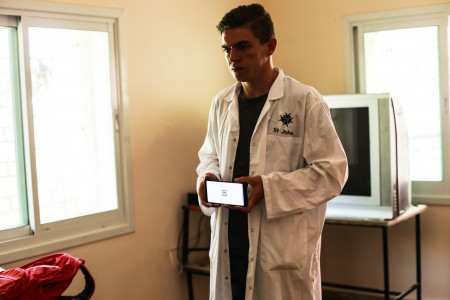
A screener for St John Eye Hospital’s RAAB Team examines a patient, West Bank.
Credit: St John Eye Hospital
A new and expanded version of the Rapid Assessment of Avoidable Blindness (RAAB) survey has officially launched, following extensive development and testing with leading eye health sector organisations. RAAB7 is delivered digitally using bespoke technology and enables faster, more accurate and more insightful data collection and analysis for effective eye health planning.
High-quality data is vital to understand the needs of a population in order to design and evaluate impactful eye health programmes to prevent vision loss. RAAB is a well-established population-based eye health survey which is used to assess the prevalence and causes of vision impairment and blindness among people aged 50 years and older, as well as recording priority eye care service indicators. The latest RAAB7 version replaces its predecessor (RAAB6) and provides enhanced functionality and greater efficiencies across multiple stages of the survey.
Powered by Peek Vision technology, RAAB7 includes new and updated features based on current eye health priorities to support users to capture the most accurate eye health planning data possible. Features include:
- A mobile app with in-built validation checks for high-quality data collection
- Integrated Peek Acuity app which has been clinically-validated to measure visual acuity
- A new web platform with live data visibility to enable real-time survey monitoring
- Data collection on a broader range of priority eye health and disability indicators
- Custom reports and templates to help users easily interpret their data
RAAB7 has been developed as a collaboration between the International Centre for Eye Health (ICEH) at the London School of Hygiene & Tropical Medicine and Peek, in consultation with a steering group of leading sector experts. Organisations represented on the steering group include the International Agency for the Prevention of Blindness (IAPB), the Vision Loss Expert Group (VLEG), the Vision Catalyst Fund, and major eye health non-governmental organisations including CBM, The Fred Hollows Foundation and Sightsavers.
Dr Hans Limburg, who first developed the RAAB methodology more than two decades ago and remains an active member of the RAAB7 steering group, said: “RAAB provides vital data for eye health planning and evaluation, but the surveys traditionally require many hours of manual data entry from paper-based forms, and this also increases the risk of inaccuracies. RAAB7 digitises and streamlines this process to save users time and resources. It enables them to collect the highest-quality data possible.”
Professor Matthew Burton, Director of ICEH, said: “RAAB7 has been designed with valuable input from the steering group to meet the evolving needs of eye health stakeholders. For the first time, RAAB users will be able to collect data on uncorrected visual acuity to calculate effective Refractive Error Coverage, as well as data on disability. These add to existing features on effective Cataract Surgical Coverage and diabetic retinopathy, to provide a more comprehensive picture aligned to universal health coverage targets.”
Future developments in RAAB7 will include near vision assessment, and there is the potential to integrate further additional features that improve the planning and evaluation of eye health programmes.
RAAB7 has been piloted by organisations including St John of Jerusalem Eye Hospital Group (SJEHG), which carried out a survey in the Occupied Palestinian Territories in 2018, funded by the The Fred Hollows Foundation.
Dr Nahed Mikki, public health lead researcher at SJEHG, commented on the experience of using RAAB7 technology for data collection: “It would have been very time consuming and costly to use paper forms, hire people for coding and data entry and check for data entry errors. It was also more accurate to use the mobile phone technology because the fieldworkers were able to correct the data entry errors on site while study participants were still present. The integrated visual acuity test app was much easier and faster to use in the community than standard vision testing using charts and screens.”
Dr Andrew Bastawrous, CEO of Peek Vision and Professor in International Eye Health at ICEH, said: “The number of people living with an untreated visual impairment is estimated to grow to almost 1.8 billion by 2050, due in part to the aging population. To address the global vision crisis we need reliable data and insights that are quick and efficient to gather and understand. RAAB7 has been designed with and for the eye health sector, powered by Peek technology. It is a powerful tool to support improvements in eye health service planning with the aim of preventing avoidable vision loss in millions of people around the world.”
Data from RAAB surveys is vital to generate global estimates of vision impairment and to monitor progress towards universal health coverage. A new website has launched as part of the RAAB7 project. This replaces the previous RAAB repository site, and collates all available RAAB data. Principal Investigators for RAAB7 surveys can choose to make further survey outputs openly available on the site, providing a wealth of valuable information for secondary analysis to support the sector.
Jude Stern, Head of Knowledge Management at IAPB, who sits on the RAAB7 steering group, said: “RAAB data plays a key role in contributing to vision loss estimates for the Vision Loss Expert Group and Global Burden of Disease model that populates IAPB’s Vision Atlas. High-quality data from future RAAB7 surveys, along with the new RAAB website to enable more in-depth analysis, will be of huge benefit to our members and the global eye health community as a whole.”
For more information on fees and next steps to complete a survey, contact enquiries@raab.world.